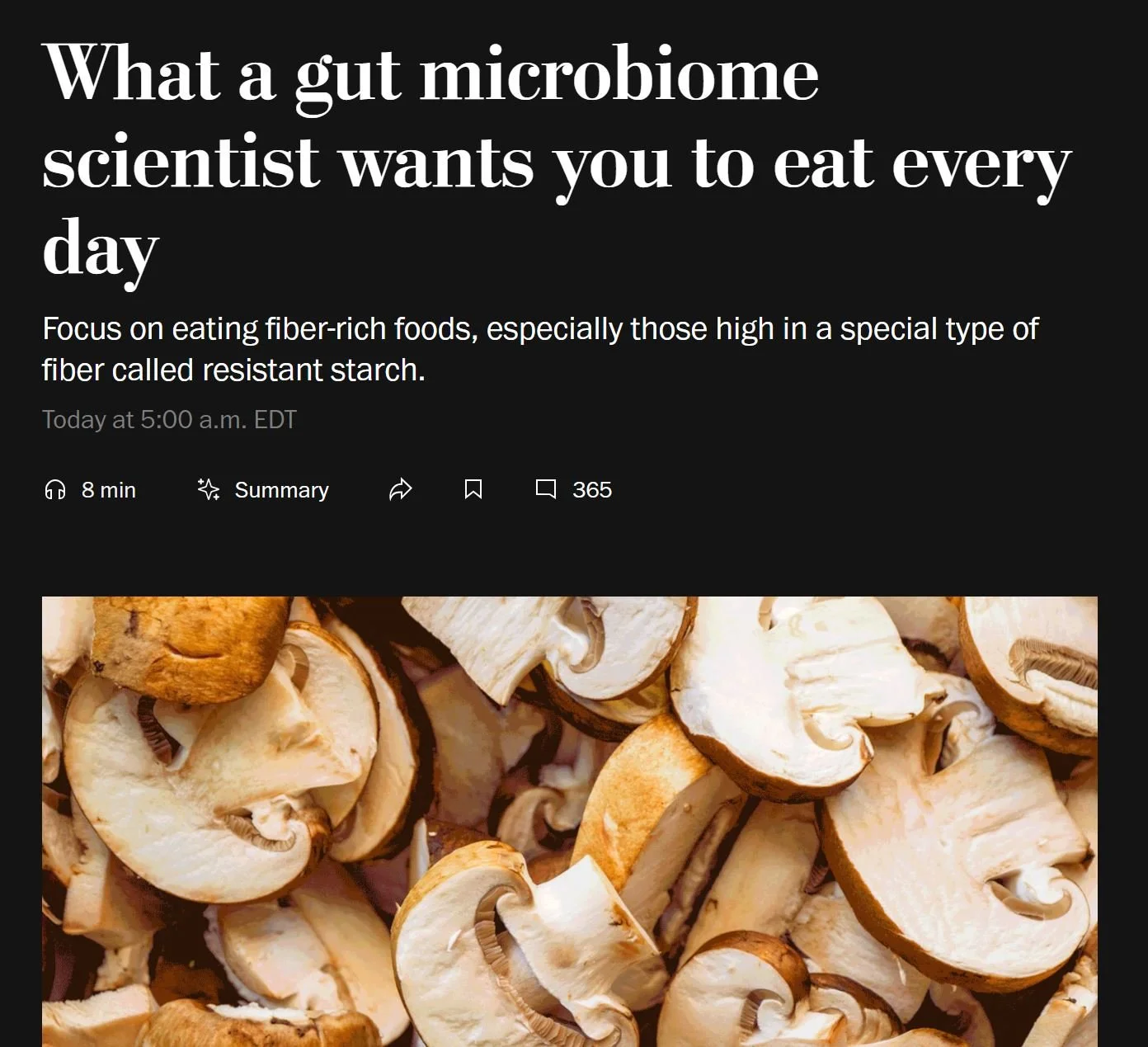THE WASHINGTONO POST - “What a gut microbiome scientist wants you to eat every day”
read the full and original article here - https://www.washingtonpost.com/wellness/2025/10/08/what-to-eat-healthy-gut-microbiome/
Focus on eating fiber-rich foods, especially those high in a special type of fiber called resistant starch.
Every time you eat a meal, you’re hosting a dinner party. Your guests are the trillions of microbes that live in your gut.
These hungry microbes, collectively known as your gut microbiome, directly affect your long-term health for better or for worse depending on what you feed them. Eat the right foods, and your gut microbes will churn out beneficial compounds that protect and improve your health. Feed them the wrong foods, and they can wreak havoc on your gut, setting off inflammation and increasing your risk of chronic diseases.
That’s according to Karen Corbin, an associate investigator at the AdventHealth Translational Research Institute of Metabolism and Diabetes in Orlando who has published groundbreaking studies on nutrition and the microbiome.
“If you take good care of your gut microbes, they’ll take good care of you,” said Corbin, who is also a registered dietitian nutritionist. “But when you don’t feed your gut microbes properly, they get hangry — they literally do. They break down the mucus layer of the gut, and they produce metabolites that aren’t healthy.”
You can make your gut microbes happy by doing the following, Corbin said: Limit your intake of ultra-processed foods, and try to eat items that contain plenty of fiber, particularly those that contain a special type of fiber called resistant starch. These include plant foods such as beans, peas, lentils, bananas (especially green bananas), apples, pears, and whole grains like barley, brown rice and oats. Health authorities recommend that adults eat around 28 grams of fiber daily — yet most people eat far less than that. If you make an effort to eat more fiber-rich foods, you’ll invariably end up eating a lot of resistant starch.
One simple thing you can do, Corbin said, is to make “upgrades” to your meals, by switching from low-fiber foods, such as white bread, to higher-fiber versions, like whole-wheat bread. “If you want to have a healthy gut, ask yourself one simple question every day: Have I fed my gut microbiome today?” Corbin said. “If the answer is no, then find something in your meals that you can upgrade.”
Here’s what you need to know about your gut microbiome and how to keep it happy.
Fuel your microbiome with fiber
Most of the microbes in your gut reside in your colon, which is near the end of your gastrointestinal tract. Your gut microbes love fiber. That’s great for us because our bodies don’t have the enzymes necessary to digest most of the fiber that we eat. Instead, the fiber that we consume travels down to the colon, where our gut microbes feast on it. As they metabolize this fiber, they produce by-products that are good for our health, such as short-chain fatty acids. These fatty acids help to lower inflammation, and they stimulate the production of GLP-1, the appetite-suppressing hormone that’s mimicked by Ozempic and Wegovy, the popular diabetes and weight-loss drugs.
Every time you eat fiber-rich plants — especially those high in resistant starch — you’re nourishing the beneficial microbes in your gut. One particular benefit of eating resistant starch is that your gut microbes will convert it into butyrate, a short-chain fatty acid that helps to reduce inflammation, though all fiber is beneficial. “The microbes in your colon turn that fiber into molecules that signal processes that are important, such as keeping your blood sugar where it needs to be and helping to release hormones that make you feel full,” Corbin said.
Ultra-processed foods have the opposite effect. These foods, such as white bread, bagels, pastries, sugary cereals, chips, crackers, cookies and desserts, tend to be very low in fiber. This extends their shelf life, and it affects their texture, making them easier to chew, swallow and digest. This causes them to be rapidly absorbed in the upper gastrointestinal tract, which means more calories for your body and fewer for your gut microbes, Corbin said. This leads to blood sugar spikes. It increases weight gain because we absorb more calories. And we effectively starve our gut microbes, because there’s little or no fiber for them to consume, Corbin said.
All calories aren’t created equal
When our gut microbes aren’t properly nourished, they end up eating the thin layer of mucus that lines our intestines, Corbin said. This mucus layer acts as a protective barrier, preventing pathogens and toxins from leaving our guts and infiltrating our bloodstreams. The destruction of this barrier can lead to chronic inflammation, infections and other disorders. Studies show that low-fiber diets cause alterations in your gut microbiome that can play a role in obesity, Type 2 diabetes and heart disease.
In one landmark study in 2023, Corbin and her colleagues recruited a group of healthy adults and fed them two different diets for roughly three weeks at a time. One diet, called the Western diet, consisted primarily of ultra-processed foods such as white bread, sweetened breakfast cereals, cheese puffs, vanilla wafers, potato chips, American cheese, sugary snacks, fruit juices, deli meats and processed meats.
The other diet, called the “microbiome enhancer diet,” was the opposite. It contained plenty of fiber-rich foods, such as fresh fruits and vegetables, nuts, seeds, whole grains and multigrain bread, as well as nutritious whole foods like plain yogurt, sirloin steak and grilled chicken.
For part of the study, the participants lived in a tiny, airtight room called a metabolic chamber, which allowed the researchers to determine exactly how many calories they burned and consumed. The researchers also collected and analyzed their bowel movements so they could determine the amount of energy and bacteria in their feces.
The scientists found that the participants absorbed fewer calories on the fiber-rich diet compared with the ultra-processed diet. They lost slightly more weight and body fat on the fiber-rich diet, and even though they absorbed fewer calories from their food, they didn’t show any signs of increased hunger. This may have been related to the fact that they produced higher levels of GLP-1, the satiety hormone, while on the fiber-rich diet. They also had higher circulating levels of health-promoting short-chain fatty acids. Microbiome analyses indicated that their gut microbes were thriving on the fiber-rich diet.
How to upgrade your meals
To maintain a healthy diet, you have to enjoy the foods that you eat. So rather than trying to force yourself to eat meals that you don’t enjoy, think about some of your favorite foods and then look for ways to “upgrade” them by choosing versions of those foods that are less processed and higher in fiber, Corbin said. Here are some ways to do that:
Breakfast: If you enjoy eating cereal in the morning, try switching to a cereal that has less sugar and more fiber. You could upgrade to steel-cut oats — which are high in resistant starch — topped with nuts, seeds and berries or sliced fruit. You could also try plain Greek yogurt, which contains plenty of protein and probiotics, topped with nut butter, berries, and flax and chia seeds, which are both good sources of resistant starch.
Lunch: If you like sandwiches for lunch, ditch the ultra-processed white bread and choose a brand that says “whole grain” or “100 percent whole grain,” such as Dave’s Killer Bread or Food for Life’s Ezekiel Bread. If you like cold cuts, choose a brand that has few additives, such as Wegmans Just Turkey Turkey Breast or Applegate sliced turkey, chicken and roast beef. You could add spinach, tomatoes, onions, peppers and other veggies to your sandwich.
Dinner: If you like pasta for dinner, try upgrading from a white pasta to a whole-wheat pasta or legume pasta made from chickpeas or edamame. These pastas contain large amounts of fiber and protein. For the sauce, add as many veggies as you can, even if it’s a store-bought pasta sauce. “When my husband makes pasta, he adds a bunch of vegetables to the sauce that he gets from the store — mushrooms, carrots, onions, peppers,” Corbin said. “You don’t even know that they’re there. Hide the vegetables in wherever you can.” Serve your pasta with the least-processed source of protein you can find, such as a lean cut of meat, grilled fish, tofu or tempeh, Corbin said.
Snacks: If you like potato chips as a snack, upgrade to something that tastes similar but is higher in fiber and better for you, such as Terra vegetable chips or crackers made from whole grains and almond flour. Some other good options are nuts, trail mix and minimally processed snack bars.
Corbin emphasized that it’s also important to be a realist. If you can eat healthy meals most of the time, that’s great. But it’s also fine to treat yourself. “I don’t eat perfectly,” she said. “I try to make the best choices that I can. But I also know that one terrible day of eating is not going to mess up your whole life.”

